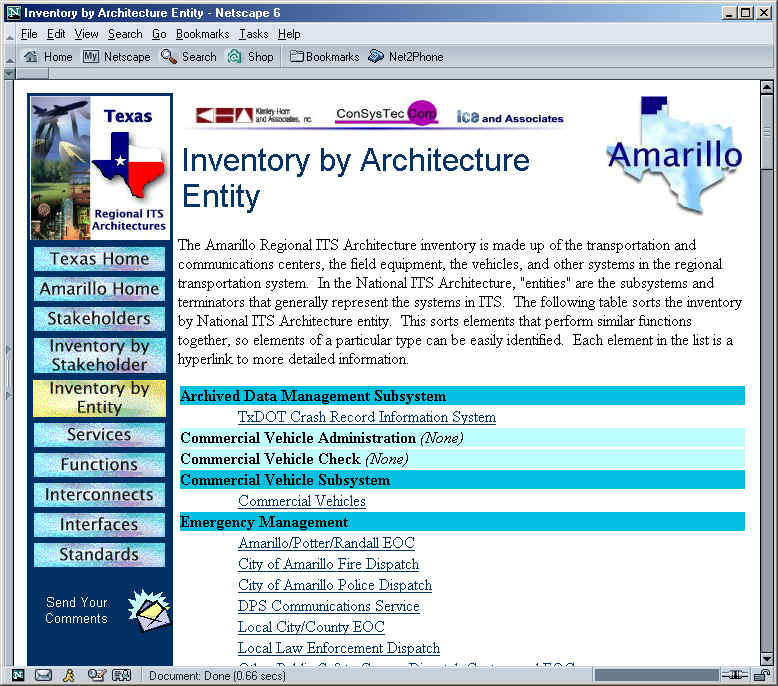
Stakeholders can find specific information relevant to their activities by following these general instructions:
·
Open your web browser to the Texas Regional ITS Architecture and
Deployments web page. This is
currently located at http://www.consystec.com/texas/default.htm.
· Select the appropriate district or Common Services architecture from the list on the left side column on the page. This will bring up the appropriate District or Common (sub) website.
· Select one of the following areas to explore
o
Architecture Interconnect ("Sausage") Diagram
The Architecture Interconnect Diagram (aka the Sausage Diagram) illustrates the
ITS subsystems and terminators present in the regional.
Along the perimeter of the diagram are tables for each subsystem and
terminator, identifying the specific local stakeholder ITS element regional instances
of the subsystem or terminator.
o
Customized Market Packages
Market Packages represent collections of subsystems and terminators that
exchange information (illustrated with architecture flows in the market package
diagrams) to do a specific service. The
market packages are customized to represent the operational concept for service
delivery specific to this region. Each
subsystem or terminator in a market package diagram is labeled with both its
generic National ITS Architecture name and the name of the local stakeholder
instance that participates in the customized market package. In this way the
market package identifies the information exchange (using architecture flows)
between specific stakeholders elements in the region to affect a particular
service or set of services.
o
Inventory by Architecture Entity or Inventory by Stakeholders
The inventory of physical elements in the region ("entities") is made
up of each local stakeholders instance of any subsystems or terminators that
they operate. The inventory can be
organized by Stakeholders (so that a stakeholder can easily see each of their
assets in the architecture) or by Architecture Entity (so an analyst or other
interested person can see all the stakeholder elements in a region of the same
type). Each entry in each of these
lists is illustrated with a Physical Element Context diagram.
This diagram illustrates all the information exchange opportunities in a
region for a single inventory element. If
that element is going to be a project, then this diagram illustrates all the
external information exchange opportunities for that element.
o
Regional Turbo Architecture Database Model
The regional ITS architecture was developed using the off-the-shelf software
program Turbo Architecture (version 2.0). Turbo
Architecture enables ITS analysts to build an MS Access 97 model for the
regional ITS architecture. The model
for this District (an MS Access 97 mdb file) can be downloaded by clicking on
the hotlink to the left. The model
file has been zipped, so after downloading, you will have to unzip it.
Then you will need to use Turbo Architecture to make use of the model.
A particularly useful approach for a stakeholder is to select Inventory by Stakeholder as described above. The stakeholder should then be able to search the alphabetically organized list of stakeholders and find themselves (or their organization). It should then be easy to see the corresponding physical elements that are allocated to the stakeholder. Each of these physical elements is a hot link, and can be clicked to get to the physical element page that will allow the user to easily see all the other elements that their element is connected to, and with which architecture flows.
The analysis of architecture flows into and out of stakeholders elements is of particular importance, as it defines at a high level the information exchange requirements with other stakeholders that a stakeholders element is involved. Stakeholders should appreciate the benefits of the information exchange. Alternatively, stakeholders may believe that additional information exchange relationships may be required to achieve some benefit. In either of these cases, the ITS architecture may require revision. A starting point for making this revision is to comment on the ITS architecture. This can be done clicking on the part of a web page that says Send Your Comments with the icon of an envelope (see for example the following figure).

Figure
1
A web page with a "send your comments" icon.